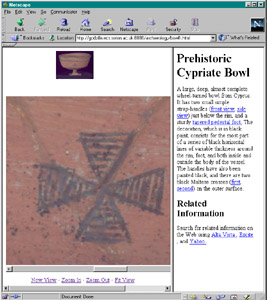
Our client-server approach is clearly slower than QTVR (once that has loaded everything - which can be slow!) in use but is more extensible. It also allows the viewer to show wha the object looks like by only fetching icon-level data.
Each of the 20-40 views is a separate TIFF file. Typically 2-3MB each, so 40 views is ~ 100MB.
The Java browser uses the Internet Imaging Protocol to fetch each tile. So as the scrollbar is moved, or the mouse drags the large view, new tiles are fetched from the server. These requests look something like this:
http://server/iipserver.fcg?FIF=monalisa.tif&OBJ=IIP,1.0&JTLS=5,4,3
IIP standardises fetching parts of images from a web server, so it allows
multi-vendor clients and servers.
 |
There are two Java applets, one for the icon and the other for the main view. The Zoom/etc controls underneath are JavaScript as are the view links in the text on the right. |